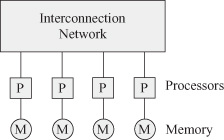3.4 DISTRIBUTED-MEMORY MULTIPROCESSOR (NONUNIFORM MEMORY ACCESS [NUMA])
In a distributed-memory multiprocessor, each memory module is associated with a processor as shown in Fig. 3.2. Any processor can directly access its own memory. A message passing (MP) mechanism is used in order to allow a processor to access other memory modules associated with other processors. Message passing interface (MPI) is a language-independent communication protocol.
Figure 3.2 Distributed-memory multiprocessor architecture.

In that sense, memory access by a processor is not uniform since it depends on which memory module the processor is trying to access. This is referred to as a NUMA multiprocessor system.
If the distributed-memory multiprocessor is composed of identical processors, we say that this is a symmetric multiprocessor (SMP). If the distributed-memory multiprocessor is composed of heterogeneous processors, we say that this is an asymmetric multiprocessor (ASMP).
When the interconnection network of the distributed-memory multiprocessor is global, such as the Internet, then the distributed memory system is usually composed of thousands of computers all collaborating to solve huge scientific problems, and the system is called by different names such as massively parallel computing, distributed computing, or grid computing.
Get Algorithms and Parallel Computing now with the O’Reilly learning platform.
O’Reilly members experience books, live events, courses curated by job role, and more from O’Reilly and nearly 200 top publishers.

